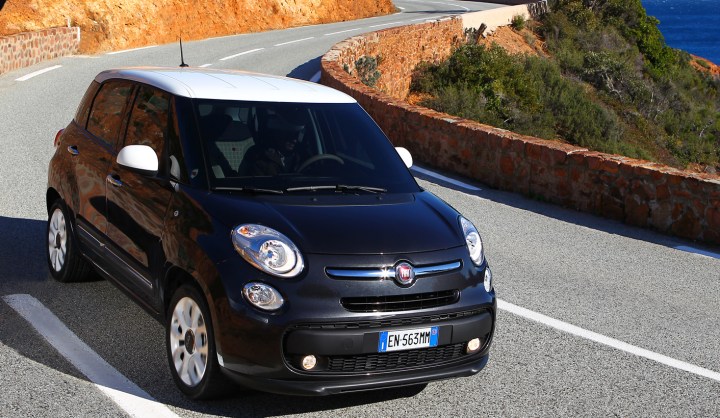Maverick Life
Fiat 500L: Mistaken identity?

Producing modern versions of classic cars can be a risky business. Volkswagen, for instance, has tried, twice, to recreate the special magic of the Beetle in the modern context, with mixed success. Mini, on the other hand, has managed to enchant a whole new generation, despite a car that is much, much bigger than the tiny original. Where does all of this leave the Fiat 500L? By DEON SCHOEMAN.
Among the biggest challenges facing motor manufacturers is creating cars with a distinctive character, and producing versatile vehicles that can fulfil multiple roles.
One way to introduce character and identity is to reach back into the past, and to create modern interpretations of classic designs. BMW’s Mini, and the Fiat 500, are arguably the most convincing, and most successful examples of this retro-reborn genre.
The ever-growing array of crossovers and multi-purpose vehicles is proof that versatility has become a key factor in new car design, too. But what happens if you mix retro and versatility? Meet the Fiat 500L.

As that designation implies, the 500L is a bigger 500. And yes, the L is an abbreviation for Large – large, that is, by Fiat 500 standards. While the little 500 is a mini-hatch, the 500L assumes a somewhat bigger, and more spacious role.
The 500L is offered in three versions, two of which are powered by the same 1.4-litre 16-valve petrol engine, while the third, flagship model’s drivetrain features a 1.6-litre turbodiesel unit. Badged the 1.6 Lounge, it also happens to be the version under scrutiny here.
The turbodiesel is a useful power plant, producing an adequate 77kW of maximum power, but linking that to a very wholesome 320Nm of torque. Drive is to the front wheels via a six-speed manual gearbox.

However, let’s not forget that the not-so-little 500L tips the scales at 1,365kg, which translates into a power-to-weight ratio of 56kW per ton. Add the fact that the first two gear ratios are almost too short, while sixth is tall enough for overdrive status, and it stands to reason that the 500L isn’t exactly a sprinter.
While the little Fiat 500 feels every inch the nippy, turn-on-a-tickey city machine, the 500L’s extra bulk and weight make for more ponderous progress. It’s not that the Fiat is unpleasant to drive. Just don’t expect the same agility as the 500.
Straightline progress is brisk, with a zero to 100 time of 11,3 seconds and a 181 km/h top speed. It’s a little laggy off the mark, but once the torque kicks in, you need to short-shift in first and second to prevent chirping rubber.

That torque also means that midrange response is good, despite the tall fifth and sixth gears. Fiat claims a combined cycle consumption figure of 4,5 litres, but we struggled to get it below 7 litres/100 km in mixed driving.
However, it’s the cabin that is the real highlight of the 500L. The Lounge designation entails a comprehensive array of standard comfort and convenience features.
Electric windows and exterior mirrors, dual-zone climate control, a glass roof, and a full-colour multifunction touchscreen display are among the highlights, as are auto-activating headlights and windscreen wipers.

The seats are plush, the ergonomics intuitive and the overall execution impressive. Six airbags and a raft of active safety systems ensure that the 500L also shines on the safety front. But it’s the 500L’s versatility that takes centre stage.
For a compact vehicle measuring just 4,15 metres long and 1,78 metres wide, the interior feels almost impossibly roomy. The secret is the elevated roof, with its glass panel, which gives cathedral-like headroom. It’s a versatile space, too, with plenty of seat-versus-cargo configurations.
For instance, the rear bench seat is split 60:40, and can be folded and tumbled forward individually. The rear seats can also slide fore and aft, depending on the need for legroom versus loading space.

It’s the 500L’s focus on space and practicality that dominates its personality – somewhat ironic, considering that much of the normal 500 hatchback’s appeal is based on its diminutive presence.
Indeed, the 500 hatch is all about cute, retro style. Its larger Fiat 500L sibling, on the other hand, places the emphasis firmly on form-following functionality. And therein lies the rub.
You see, the 500L has had to grow significantly in every dimension. And in that process, it’s lost much of its retro appeal. It may bear the 500 badge, but it’s about as cute as a bread bin, and about as retro as a workshop manual.
Which is not to say that the 500L is a bad car: quite the opposite. But the badge presupposes a certain quirkiness, a small-car cuteness, that by definition, the 500L simply cannot live up to.

Is it possible to produce a car with an ultra-compact form factor that still provides ample interior space, and retains some of that vital small car character? Almost six decades ago, Fiat produced a small people carrier it called the 600 Multipla.
It was an obnoxious looking little machine, with a blunt front end, wheels at each corner and seating for six. It certainly wasn’t pretty – but it had head-turning character, and it oozed innovation. By comparison, the 500L lacks the vital sparkle of individuality.
Perhaps Fiat shouldn’t have badged this mini-MPV a 500L. That badge creates too many expectations which the little crossover struggles to meet.

All the more’s the pity, because it’s an appealing little beast, with ample space, loads of versatility and a smart interior. Dressed in something more contemporary, and more dashing, the 500L would have been allowed to develop and exude a personality of its own – a bit like that 1956 Fiat Multipla. DM
|
Fiat 500L 1.6 Multijet Lounge
|

















 Become an Insider
Become an Insider